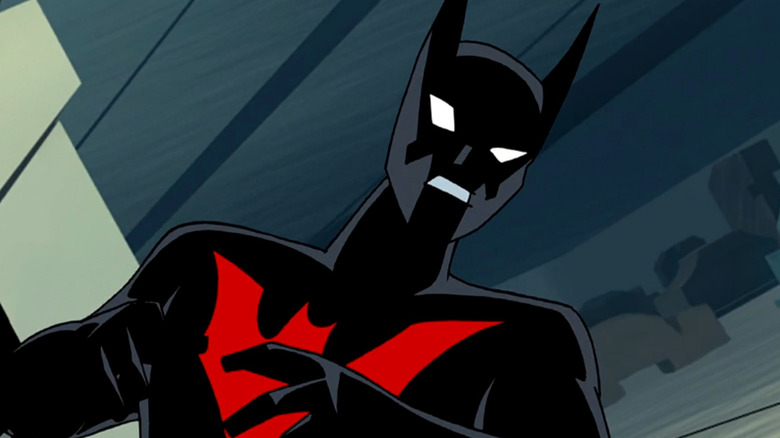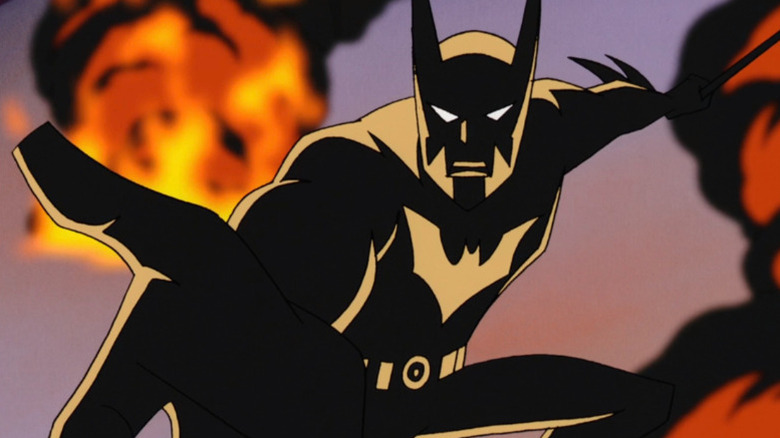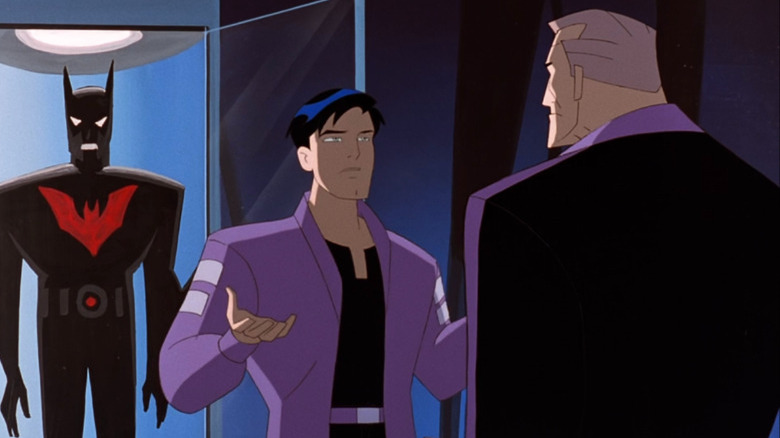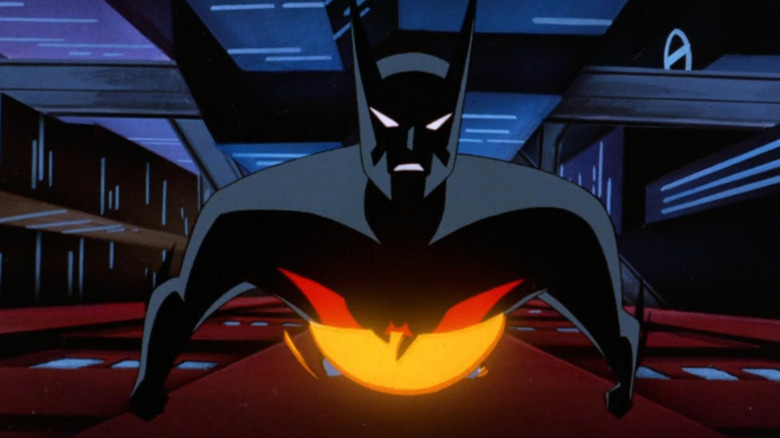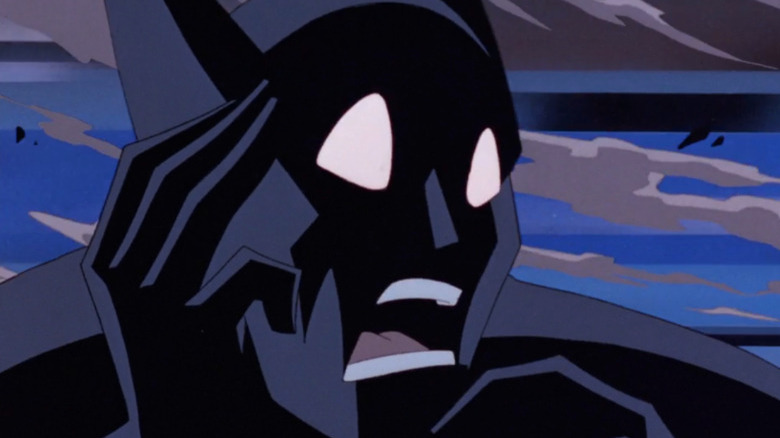Bruce Timm Hated The Network's Original Pitch For Batman Beyond
If there's one thing we know for certain about Batman, it's that the superhero has only one interpretation that works, and that any deviation from that interpretation will cause all the fans to reject the character outright. There's just no room in this world for funny versions of Batman, or grimdark versions of Batman, or futuristic versions of Batman, or young versions of Batman. At all. Ever.
(Hang on, I'm getting a note from my editor.)
Actually never mind, strike all that entirely. Because the exact opposite is true. Batman is one of the most adaptable characters in pop culture history and has been repeatedly redefined, redesigned, and reintroduced to audiences in a menagerie of different forms. Some were successful and some weren't, but none of them managed to ruin the character of Batman. Even with that being said, Bruce Timm, the producer of the groundbreaking TV classic "Batman: The Animated Series," actually despised the original pitch for the animated spin-off "Batman Beyond."
Let's talk about why.
Can't we get 'beyond' Batman?
"Batman: The Animated Series" debuted in 1992, and although the show was clearly influenced by the German Expressionism-meets-gangster noir style of Tim Burton's blockbuster films, it quickly found its own voice. The series featured Bruce Wayne (voiced by the late Kevin Conroy) donning the Batman costume and doing battle with some of his most iconic villains, with classically melodramatic stories and animation that, especially for television in the 1990s, was ahead of the curve with its striking designs and fluid action.
The show was such a smash hit that multiple spin-offs were eventually released, including "Superman: The Animated Series," "Justice League," and "Static Shock." But one of the boldest extensions of "Batman: The Animated Series" was a futuristic version of the show, set in the far-off year of 2019 (ahem), where advanced technology has completely changed Gotham City into a dystopian world not entirely unlike "Blade Runner."
"Batman Beyond" saw the return of Bruce Wayne, but as a retired crimefighter who passes his mantle on to a teenage hero named Terry McGinnis. Since Terry doesn't have the luxury of spending years traveling the world and acquiring the original Batman's skills, Wayne equips Terry with an advanced suit of armor that gives him extraordinary abilities, including the power of flight, and he advises the rookie superhero from the safety of the Batcave.
"Batman Beyond" may not have been as huge a success as "Batman: The Animated Series," but the show was well-received. The show lasted 52 episodes over the course of three seasons, and spawned the acclaimed movie "Batman Beyond: Return of the Joker" in 2000, as well as a short-lived animated spin-off series called "The Zeta Project."
But despite all of that success, at first, Bruce Timm just wasn't interested.
The bat pitch project
Don't judge Bruce Timm too harshly, because the origin of "Batman Beyond" was a network pitch that had very little to do with what the actual series would become.
In a meeting with Jamie Kellner, who was currently the head of WB television, Kellner told Bruce Timm and fellow producers Alan Burnett and Paul Dini that he wanted another Batman series. Except this time, Bruce Wayne would be a teenager. According to an oral history collected by IGN, Bruce Timm did not take the suggestion well:
"I'm not sure I can adequately describe [my feelings] at that moment. It was surreal and disappointing, shocking, and dream-like. Like this can't be happening. It was not the words I expected to hear, let's just say that [...] We were in the middle of doing our second iteration of Batman, 'The New Batman Adventures.' We'd found our groove, we were digging the look of the show, we were digging the scripts and stuff, we were on fire."
"So to have the rug pulled out from under us," Timm added, "It was just like, 'Oh God, seriously?'"
Timm's fear was that Kellner's pitch wouldn't add to the continuity they had been building with "Batman: The Animated Series" and "Superman: The Animated Series," but overwrite it completely. Not wanting to lose their years of hard work, Timm decided to approach the idea from a new angle — an idea that went beyond (ahem) Kellner's original pitch.
"I said, 'So if there was some way that we could come up with a teenage Batman show that was still in continuity, that's still built off of the shows that we had already done, the only way really to do that is to go forward into the future and introduce a new character, a new Batman.'"
Son of a pitch
Working with James Tucker, a storyboard artist and character designer who would go on to direct multiple episodes of "Batman Beyond," Bruce Timm and Alan Burnett developed the idea of young Terry McGinnis working with an elderly Bruce Wayne. The idea would kill two birds with one stone, de-aging the character of Batman while simultaneously incorporating a suggestion the network and toy company had been pushing for: Batman in the future.
"If the network wanted a future show," Tucker told IGN, "this was how they wanted to do it." Jamie Kellner's reaction to the updated pitch, however, was not quite what Timm expected:
"I'll never forget, Jamie's reaction was ... it was kind of odd, and I remember this specifically. He said, 'Yeah, it's like the new generation of samurai passing his sword onto his protégé.' And I thought, 'Well, I don't really know what that's about, but yeah. Yeah, like that,'" Timm said.
Kellner liked the idea and told Timm to make the show, but there was just one problem. "I said, 'So great, so the next steps are what? We'll go off and get something on paper and start developing?'" Timm remembered. "He said, 'Oh no, no. You got a green light. I want this show for next fall'", recalled Timm. "And we're just like, 'Uh, what?' It was that immediate."
Batman: Into the Spider(ish)-verse
So "Batman Beyond" was getting made, and fast, but the producer of the series still wasn't completely sold on his own idea. "Paul [Dini] and Alan [Burnett] and I walked out of the room and we met in the parking lot as we're getting into our cars and just kind of b****** and moaned about it," Bruce Timm told IGN. "It was like, 'Oh, I don't want to do this stupid show, I don't want to do teenage Batman, blah, blah, blah.'" he continued. "We wanted to keep doing the show we were doing, even though we knew that was pretty much a lost cause, so we just kind of walked away, grumbling, not really very enthusiastic about it."
It wasn't until Timm spoke to producer Glen Murakami a few days later that Timm finally acknowledged the potential of the show. And ironically, that potential had less to do with the DC superhero Batman than it did with Marvel superhero Spider-Man. Murakami thought a futuristic show with a teenage Batman would be a great way to incorporate elements of the Spider-Man character. "With the tortured hero, he's got to balance his schoolwork and his love life and being a superhero," Timm recalled. Murakami's input was a game-changer, and Timm was suddenly a lot more interested in a stylish, futuristic version of Gotham.
The rest, as they say, wasn't history: It was the future. The "far-off" future of 2019, that is.
